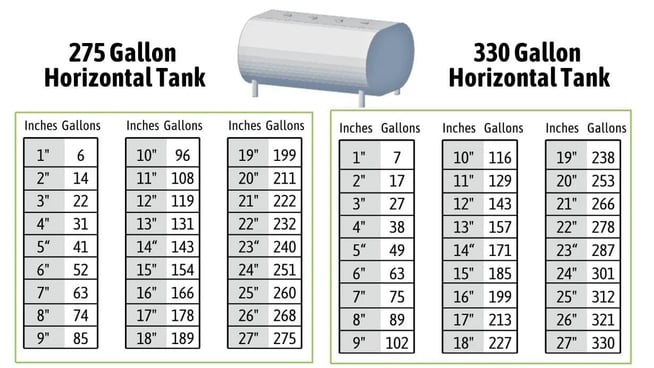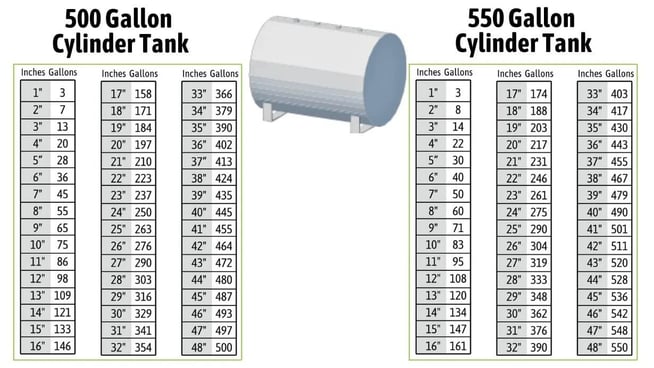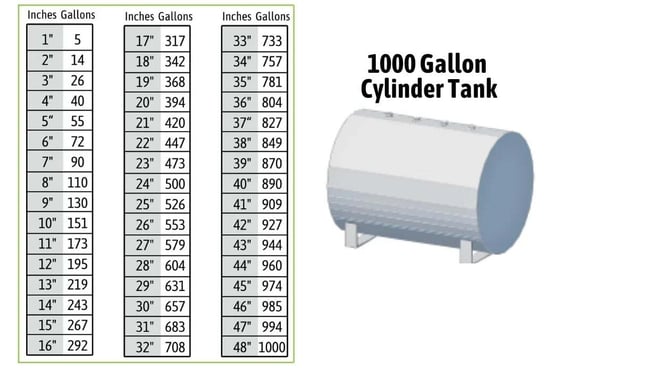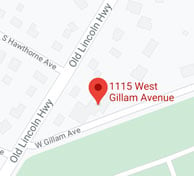Many residential heating oil tanks come equipped with a float gauge that provides a rough estimate of the tank's fullness. However, this method is not always accurate for measuring oil levels. While the float gauge may give you a general idea of how much oil is in the tank (unless it's not working due to sludge buildup or other issues), it's not reliable for determining the exact amount of heating oil you have. In such cases, the most precise way to manually measure the oil level is by using a long, clean stick. In this blog, we will cover different tank sizes and how much oil you have based on your measuring stick.
How to Measure Your Oil Level
First, make sure you know your correct tank size/type: 275 gallon vertical, 275 gallon horizontal, 330 gallon vertical, 330 gallon horizontal, 500 gallon cylinder, 550 gallon cyliner, and 1000 gallon cylinder are the most common types of residential heating oil tanks.
To measure the oil level using a tank stick, remove the plug or cap from the top of the tank and lower the stick straight down into the hole until it touches the bottom of the tank. Then, carefully remove the stick and measure the number of inches of oil shown on it. Next, refer to your corresponding fuel oil tank chart below to estimate the number of gallons in the tank. Although this measurement may not be exact, it should be fairly accurate.

Vertical Tanks:


Horizontal Tanks:

Cylinder Tanks:


When to Order Oil Based on Your Fuel Level
If you're measuring your fuel oil tank to determine how much oil to order, keep in mind that oil companies don't fill tanks to the brim. We always leave room in the tank for expansion. As a general rule, we aim to fill the tank to about 90% of its rated capacity, which is usually around 250 gallons in a 275-gallon tank, for example.
One important rule to remember when it comes to ordering oil is not to let your oil level drop below one-quarter (1/4) of the tank. It may be tempting to push it to the limit and try to squeeze every last drop of oil out of the tank, but running out of oil can lead to a host of issues and inconveniences.
When your oil level drops too low, your heating system may struggle to function properly, resulting in reduced efficiency and potential damage to the system. This can lead to costly repairs and a longer wait for your home to reach a comfortable temperature again.
Other Ways to Monitor Your Oil Levels
On another note, if you're tired of using a stick to measure your oil level, consider other options such as Automatic Oil Delivery, a Sonar Tank Gauge, or a Smart Tank Gauge.
ECI Comfort offers an automatic delivery program to take the hassle out of monitoring your oil levels and ordering refills. By monitoring your oil usage, we can schedule deliveries when your tank needs refilling without you having to check your tank. Sonar and smart gauges sit on the top of your above-ground tank and send alerts to a controller or smartphone to provide you real-time oil levels and alert you when you're running low.
If you live in the Delaware Valley/Greater Philadelphia area and would like to find comfort within your home, visit our website or give us a call at 215 - 245 - 3200 to learn more.




